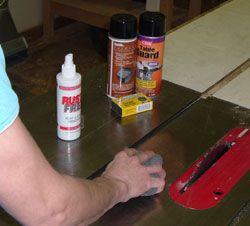
The absolute best way to eliminate rust from the surfaces of machines and other tools in your shop is to stop it from
ever really getting started in the first place.
It's always best to immediately remove any surface rust the moment you notice its presence.
Sandflex Rust Erasers work extraordinarily well to
remove light rusting or spots of rust beginning to form on surfaces. The longer rust lingers on a
metal surface, the deeper it penetrates and the more elbow grease you'll end up needing to use to get rid of
it.
Preventing Rust
There are many aftermarket coating products you can apply to help fight rust formation. Perhaps our most
popular rust preventive product is none other than
Renaissance Wax. Besides protecting your tool surfaces from corrosion of any type,
it also works as a superb friction reducer. Work using tools like your hand planes, jointer, bandsaw and tablesaw will go far
more efficiently when micro-crystalline Renaissance Wax has polished and smoothed the work surfaces.
We apply Renaissance Wax with either a fine nylon
Scotchbrite Pad
or
4/0 steel wool, putting it on as thinly as
possible and buffing it vigorously with a soft cloth after a very short wait. It takes two or three
coats to do a thorough job the first time out, but single coats thereafter will maintain a nearly
perfect surface, and it has the wonderful property of polishing metal smoother and smoother with every
use — after a few years your jointer beds and plane soles will be as smooth as glass.
Other products such as
GlideCote
spray on and form an invisible film to keep moisture at bay.
Another product,
Boeshield T-9
, is for long-term rust prevention when storing your tools.
It has a waxy emulsion that creates a barrier that lasts for months. The coating should be cleaned
off before using the machine. To remove the film when it's time to put your tools back into
service, just spray on a fresh coat of Boeshield and then wipe off thoroughly.
Removing Rust
If the top of your tablesaw, bandsaw or other tool has started to rust, you can remove it
by abrading it away. Sanding the metal top removes the
rust but also leaves scratches. You will need to sand with finer and finer
sandpaper to remove the scratches from the previous grit.
I would start with a somewhat fine grit so you don't get overly aggressive and can see how quickly
things move along.
320 or 400 grit wet-dry paper
with some mineral spirits as a lubricating agent
would be a good start. Very mild rust may come off with a nylon
Scotchbrite Pad. If the rust removal is slow going, step down a grit.
Once you have all the rust off, you can stop there or step up to the next grit to remove the
previous grit's scratches. There are also rust removal products available such as
Rust Free
that work to remove surface rust and light to moderate scale
from iron surfaces. Rust Free is acidic and should be used with care. Follow the label directions carefully.
Deep rust can cause pitting that you may not be able to remove with simple sanding. However, while
perhaps unsightly, small pitting should not impede the function of the tool. With severe pitting,
surface grinding at a machine shop would be necessary.
Remember, rust never sleeps!
It is best to prevent it from ever getting started, but
once it does start, the quicker you can attack it, the easier it will be to remove.